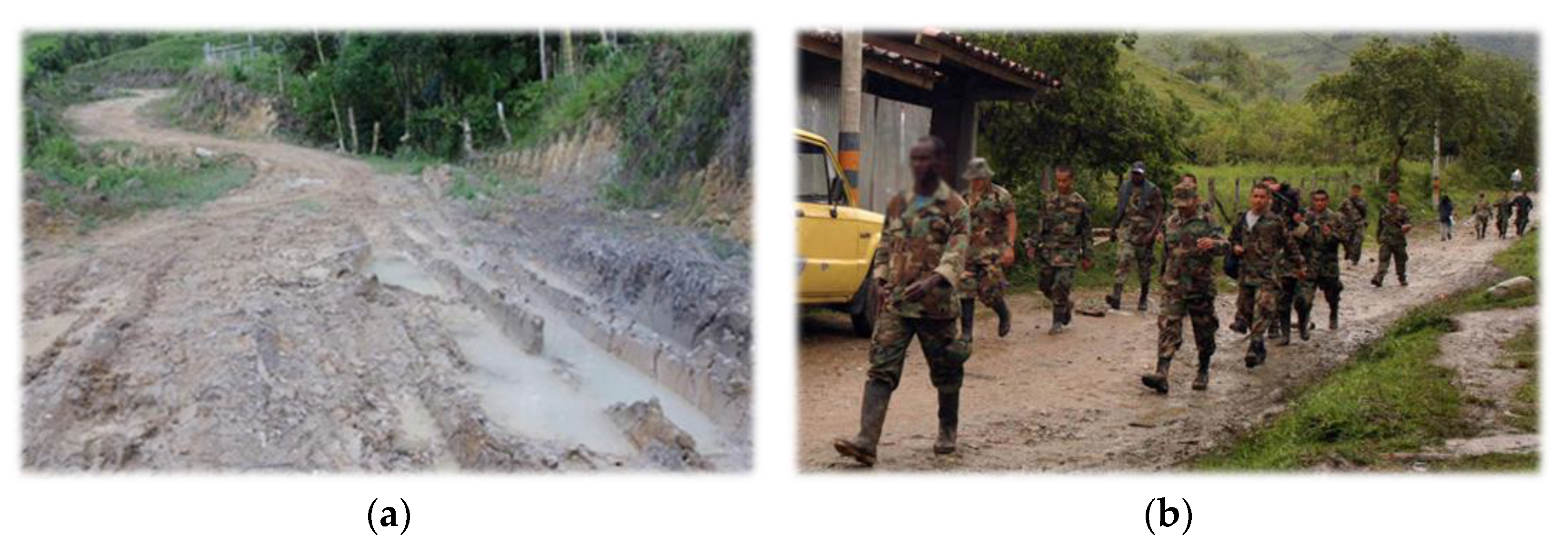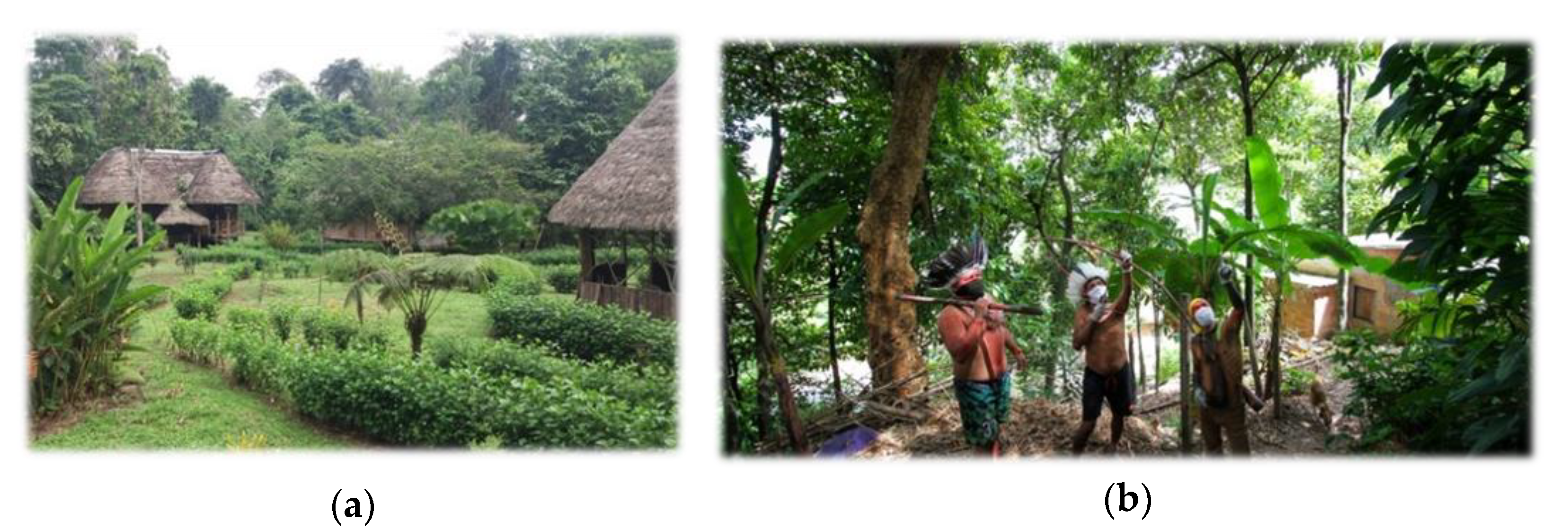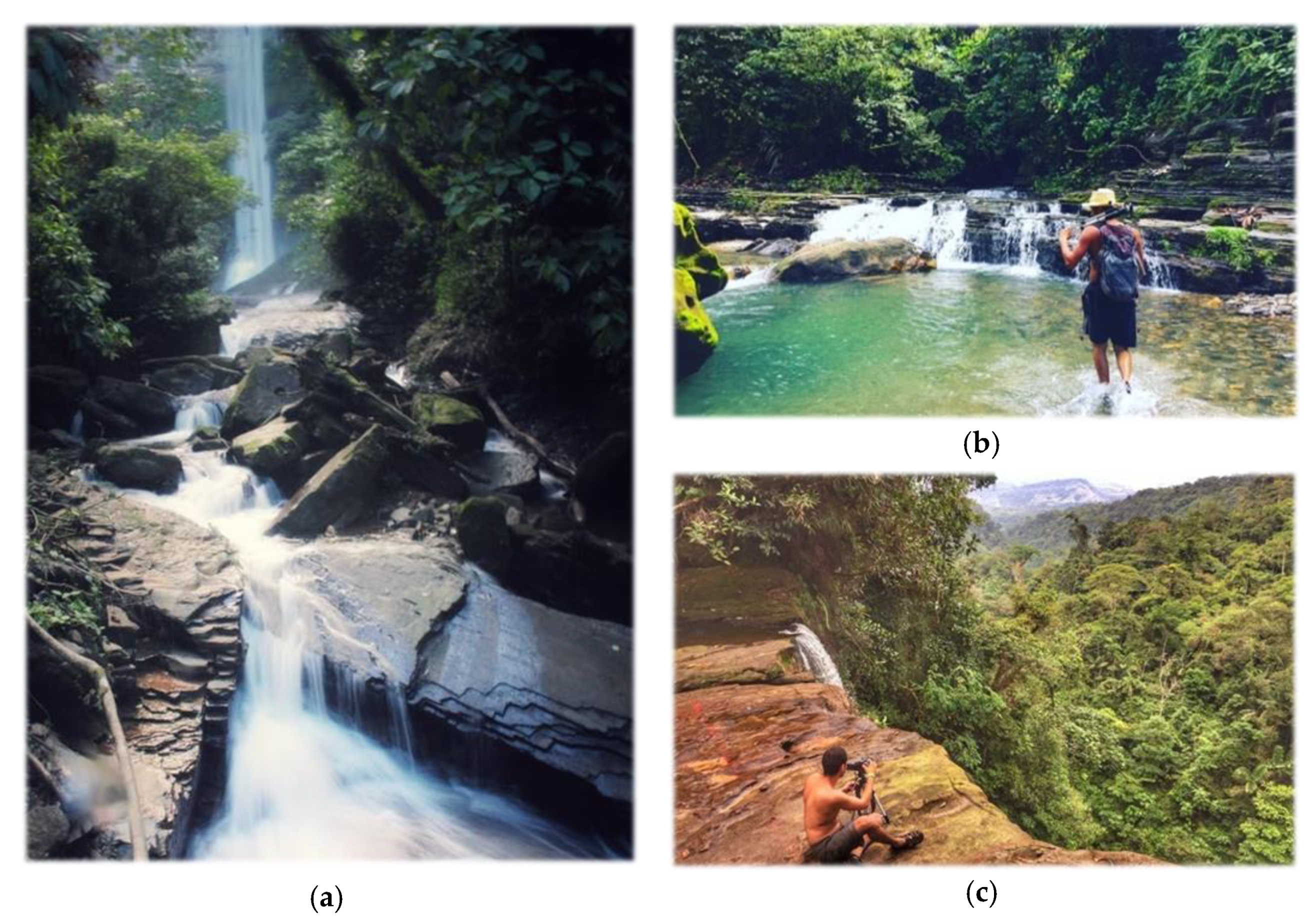Nature Tourism on the Colombian—Ecuadorian Amazonian Border: History, Current Situation, and Challenges
Abstract
:1. Introduction
2. Methodology
3. Results
3.1. History of Conflict and Post-Conflict in Nature Tourism
3.2. Current Situation and the Pandemic Crisis in Nature Tourism
3.3. Post-Conflict and Post-Pandemic Challenges in Nature Tourism
4. Discussion
5. Conclusions
Author Contributions
Funding
Institutional Review Board Statement
Informed Consent Statement
Data Availability Statement
Acknowledgments
Conflicts of Interest
References
- UNWTO World Tourism Barometer and Statistical Annex, January 2020; UNWTO World Tourism Barometer: Madrid, Spain, 2020; Volume 18, pp. 1–6.
- Mooser, A.; Anfuso, G.; Mestanza, C.; Williams, A. Management Implications for the Most Attractive Scenic Sites along the Andalusia Coast (SW Spain). Sustainability 2018, 10, 1328. [Google Scholar] [CrossRef] [Green Version]
- Fotiadis, A.; Polyzos, S.; Huan, T.-C.T.C. The good, the bad and the ugly on COVID-19 tourism recovery. Ann. Tour. Res. 2021, 87, 103117. [Google Scholar] [CrossRef] [PubMed]
- Shao, Y.; Huang, S.; Wang, Y.; Li, Z.; Luo, M. Evolution of international tourist flows from 1995 to 2018: A network analysis perspective. Tour. Manag. Perspect. 2020, 36, 100752. [Google Scholar] [CrossRef] [PubMed]
- Moreno-Luna, L.; Robina-Ramírez, R.; Sánchez, M.S.; Castro-Serrano, J. Tourism and Sustainability in Times of COVID-19: The Case of Spain. Int. J. Environ. Res. Public Health 2021, 18, 1859. [Google Scholar] [CrossRef]
- Zielinski, S.; Botero, C.M. Beach Tourism in Times of COVID-19 Pandemic: Critical Issues, Knowledge Gaps and Research Opportunities. Int. J. Environ. Res. Public Health 2020, 17, 7288. [Google Scholar] [CrossRef]
- Sumanapala, D.; Wolf, I.D. Think globally, act locally: Current understanding and future directions for nature-based tourism research in Sri Lanka. J. Hosp. Tour. Manag. 2020, 45, 295–308. [Google Scholar] [CrossRef]
- Ingólfsdóttir, A.H.; Gunnarsdóttir, G.Þ. Tourism as a tool for nature conservation? Conflicting interests between renewable energy projects and wilderness protection in Iceland. J. Outdoor Recreat. Tour. 2020, 29, 100276. [Google Scholar] [CrossRef]
- Auster, R.E.; Barr, S.W.; Brazier, R.E. Wildlife tourism in reintroduction projects: Exploring social and economic benefits of beaver in local settings. J. Nat. Conserv. 2020, 58, 125920. [Google Scholar] [CrossRef]
- Paunović, I.; Jovanović, V. Implementation of Sustainable Tourism in the German Alps: A Case Study. Sustainability 2017, 9, 226. [Google Scholar] [CrossRef] [Green Version]
- Ramón, C.M.; Villacís, M.A.T.; García, A.E.C. Tortugas Charapa un aporte para el turismo comunitario y conservación de la biodiversidad. Explor. Digit. 2020, 4, 55–65. [Google Scholar] [CrossRef]
- Ramon, C.M.; Capa, M.S.; Garcia, A.C.; Gutierrez, M.J.; Villacís, M.T.; Velasco, A.A. Community Tourism In Ecuador: A Special Case In The Rio Indillama Community, Yasuní National Park. Int. J. Eng. Res. Technol. 2019, 8, 5. [Google Scholar]
- Mestanza, C.; Saavedra, H.F.; Gaibor, I.D.; Zaquinaula, M.A.; Váscones, R.L.; Pacheco, O.M. Conflict and impacts generated by the filming of Discovery Channel’s reality series “Naked and Afraid” in the Amazon: A Special case in the Cuyabeno Wildlife Reserve, Ecuador. Sustainability 2019, 11, 50. [Google Scholar] [CrossRef] [Green Version]
- Lokhandwala, S.; Gautam, P. Indirect impact of COVID-19 on environment: A brief study in Indian context. Environ. Res. 2020, 188, 109807. [Google Scholar] [CrossRef] [PubMed]
- Pulido-Fernández, D.M.; Pulido-Fernández, I.J. Is There a Good Model for Implementing Governance in Tourist Destinations? The Opinion of Experts. Sustainability 2019, 11, 3342. [Google Scholar] [CrossRef] [Green Version]
- Mikulić, J.; Miloš Sprčić, D.; Holiček, H.; Prebežac, D. Strategic crisis management in tourism: An application of integrated risk management principles to the Croatian tourism industry. J. Destin. Mark. Manag. 2018, 7, 36–38. [Google Scholar] [CrossRef]
- Karl, M. Risk and Uncertainty in Travel Decision-Making: Tourist and Destination Perspective. J. Travel Res. 2016, 57, 129–146. [Google Scholar] [CrossRef]
- Mamula Nikolić, T.; Pantić, S.P.; Paunović, I.; Filipović, S. Sustainable Travel Decision-Making of Europeans: Insights from a Household Survey. Sustainability 2021, 13, 1960. [Google Scholar] [CrossRef]
- Paunović, I.; Dressler, M.; Mamula Nikolić, T.; Popović Pantić, S. Developing a Competitive and Sustainable Destination of the Future: Clusters and Predictors of Successful National-Level Destination Governance across Destination Life-Cycle. Sustainability 2020, 12, 4066. [Google Scholar] [CrossRef]
- Hassan, S.B.; Soliman, M. COVID-19 and repeat visitation: Assessing the role of destination social responsibility, destination reputation, holidaymakers’ trust and fear arousal. J. Destin. Mark. Manag. 2020, 19, 100495. [Google Scholar] [CrossRef]
- McGinlay, J.; Gkoumas, V.; Holtvoeth, J.; Fuertes, R.F.; Bazhenova, E.; Benzoni, A.; Botsch, K.; Martel, C.C.; Sánchez, C.C.; Cervera, I.; et al. The Impact of COVID-19 on the Management of European Protected Areas and Policy Implications. Forests 2020, 11, 1214. [Google Scholar] [CrossRef]
- Andries, D.M.; Arnaiz-Schmitz, C.; Díaz-Rodríguez, P.; Herrero-Jáuregui, C.; Schmitz, M.F. Sustainable Tourism and Natural Protected Areas: Exploring Local Population Perceptions in a Post-Conflict Scenario. Land 2021, 10, 331. [Google Scholar] [CrossRef]
- Mestanza-Ramón, C.; Pranzini, E.; Anfuso, G.; Botero, M.C.; Chica-Ruiz, A.J.; Mooser, A. An Attempt to Characterize the “3S” (Sea, Sun, and Sand) Parameters: Application to the Galapagos Islands and Continental Ecuadorian Beaches. Sustainability 2020, 12, 3468. [Google Scholar] [CrossRef] [Green Version]
- Mestanza-Ramón, C.; Sanchez Capa, M.; Figueroa Saavedra, H.; Rojas Paredes, J. Integrated Coastal Zone Management in Continental Ecuador and Galapagos Islands: Challenges and Opportunities in a Changing Tourism and Economic Context. Sustainability 2019, 11, 6386. [Google Scholar] [CrossRef] [Green Version]
- Melián Alzola, L.; Fernández Monroy, M.; Hidalgo Peñate, M. El Sector Turístico en Contextos de Crisis: Análisis de Situaciones de Riesgo e Implicaciones Directivas para el Sector Hotelero en Canarias. Universia Bus. Rev. 2015, 45, 110–129. [Google Scholar]
- Requejo-Fraile, M. Resiliencia en fases de posconflicto: Una revisión teórica de sus métodos de implementación desde las aulas. Educ. Humanismo 2019, 21, 139–157. [Google Scholar] [CrossRef] [Green Version]
- Pinheiro, S.; Pesoa, J.; Sonaglio, K. Análisis Del Comportamiento Resiliente De Los Gestores De Turismo. Estud. Perspect. Tur. 2020, 29, 331–348. [Google Scholar]
- Ulqinaku, A.; Sarial-Abi, G. Tourism implications of online response to terrorism. Ann. Tour. Res. 2021, 86, 102914. [Google Scholar] [CrossRef]
- Samitas, A.; Asteriou, D.; Polyzos, S.; Kenourgios, D. Terrorist incidents and tourism demand: Evidence from Greece. Tour. Manag. Perspect. 2018, 25, 23–28. [Google Scholar] [CrossRef] [Green Version]
- Song, H.; Livat, F.; Ye, S. Effects of terrorist attacks on tourist flows to France: Is wine tourism a substitute for urban tourism? J. Destin. Mark. Manag. 2019, 14, 100385. [Google Scholar] [CrossRef]
- Reddy, M.V.; Boyd, S.W.; Nica, M. Towards a post-conflict tourism recovery framework. Ann. Tour. Res. 2020, 84, 102940. [Google Scholar] [CrossRef]
- Çakmak, E.; Isaac, R.K. Drawing tourism to conflict-ridden destinations. J. Destin. Mark. Manag. 2016, 5, 291–293. [Google Scholar] [CrossRef]
- Mosquera-Laverde, W.E.; Vásquez-Bernal, O.A.; Gomez-E, C.P. Eco-touristic foresight in the Colombian post-conflict for the sustainability of the tourist service with emphasis on ecological marketing. Buenaventura case. In Proceedings of the International Conference on Industrial Engineering and Operations Management, Pilsen, Czech Republic, 23–26 July 2019; pp. 2428–2436. [Google Scholar]
- González-Cortés, L.D.; Husain-Talero, S. Social entrepreneurship and sustainable tourism in Colombia: A baseline study in post-conflict regions. Int. J. Sustain. Econ. Soc. Cult. Context 2020, 16, 65–85. [Google Scholar] [CrossRef]
- Guasca, M.; Vanneste, D.; Van Broeck, A.M. Peacebuilding and post-conflict tourism: Addressing structural violence in Colombia. J. Sustain. Tour. 2021, 1–17. [Google Scholar] [CrossRef]
- Menchero-Sánchez, M. Colombia en posconflicto: ¿turismo para la paz o paz para el turismo? Araucaria 2018, 20, 415–438. [Google Scholar] [CrossRef]
- Bassols, N. Branding and promoting a country amidst a long-term conflict: The case of Colombia. J. Destin. Mark. Manag. 2016, 5, 314–324. [Google Scholar] [CrossRef]
- Ocampo-Peñuela, N.; Winton, R.S. Economic and Conservation Potential of Bird-Watching Tourism in Postconflict Colombia. Trop. Conserv. Sci. 2017, 10. [Google Scholar] [CrossRef]
- McClanahan, B.; Parra, T.S.; Brisman, A. Conflict, environment and transition: Colombia, ecology and tourism after demobilisation. Int. J. Crime Justice Soc. Democr. 2019, 8, 74. [Google Scholar] [CrossRef]
- Navarro, J.-C.; Arrivillaga-Henríquez, J.; Salazar-Loor, J.; Rodriguez-Morales, A.J. COVID-19 and dengue, co-epidemics in Ecuador and other countries in Latin America: Pushing strained health care systems over the edge. Travel. Med. Infect. Dis. 2020, 37, 101656. [Google Scholar] [CrossRef] [PubMed]
- Paladines, F.; Valarezo, K.; Velásquez, A.; Torres, S. Gestión de la comunicación estratégica digital de las principales empresas del sector turístico y gastronómico del Ecuador. Rev. Ibérica Sist. Tecnol. Inf. 2020, E35, 586–599. [Google Scholar]
- Soto, C.M.D.; Torres, J.I. Análisis de las medidas tomadas por los Gobiernos de Colombia y Ecuador a favor de la industria turística durante la pandemia generada por el COVID-19. Rev. Ibérica Sist. Tecnol. Inf. 2020, E36, 127–139. [Google Scholar]
- Paz-Gómez, D.M.; Enríquez, M.C.S. Capacidades de política en tiempos de Covid-19: Comprendiendo las respuestas económicas de Colombia y Ecuador. Análisis Político 2020, 33, 72–91. [Google Scholar]
- Araujo, E.J.S.; Melchán, J.A.S.; Bermejo, B.R.; Del Río, J.J.T. Comportamiento del sector turístico colombiano durante la pandemia, una luz al final del camino:¿ Lamentación o llamado a la acción? Rev. Ibérica Sist. Tecnol. Inf. 2020, E36, 295–308. [Google Scholar]
- Hernández-Zelaya, S.L. The country brand in times of confinement: Analyzing the publicity message of tourism promotion of Spain and Colombia during COVID-19. La marca país en tiempos de confinamiento: Analizando el mensaje publicitario de promoción turística de España y Colomb. Rev. Ibérica Sist. Tecnol. Inf. 2020, 2020, 323–340. [Google Scholar]
- Antošová, G.; Lima Santos, L.; Stradová, S. Perception of Safety Tourism in Colombia BT. In Advances in Tourism, Technology and Systems; Abreu, A., Liberato, D., González, E.A., Garcia Ojeda, J.C., Eds.; Springer: Singapore, 2021; pp. 96–105. [Google Scholar]
- Loor Bravo, L.; Plaza Macías, N.; Medina Valdés, Z. Turismo comunitario en Ecuador: Apuntes en tiempos de pandemia. Rev. Cienc. Soc. 2021, 27, 265–277. [Google Scholar]
- Beltrán, J.P. Territorio, Colonización y Diversidad Cultural en el Alto Putumayo; Centro Editorial; Universidad Nacional de Colombia: Bogota, Colombia, 2003; Volume 8, ISBN 2256-201X. [Google Scholar]
- Cancimance López, J.A. Echar Raíces en Medio del Conflicto Armado: Resistencias Cotidianas de Colonos en Putumayo; Centro Editorial de la Facultad de Ciencias Humanas de la Universidad: Bogota, Colombia, 2014; ISBN 9587832450. [Google Scholar]
- Chaves, M.; Hoyos, J.F. El estado en las márgenes y las márgenes como estado: Transferencias económicas y gobiernos indígenas en Putumayo. La Multicult. Estatalizada Indígenas Afrodescendientes y Config. Estado 2011, 115–134. [Google Scholar]
- Rodríguez, A.C.T.; Binda, E.; Ochoa Quintero, J.M.; Garcia, H.; Gómez, B.; Soto, C.; Martínez, S.; Clerici, N. Answering the right questions. Addressing biodiversity conservation in post-conflict Colombia. Environ. Sci. Policy 2020, 104, 82–87. [Google Scholar] [CrossRef]
- Mestanza-Ramón, C.; Henkanaththegedara, S.M.; Vásconez Duchicela, P.; Vargas Tierras, Y.; Sánchez Capa, M.; Constante Mejía, D.; Jimenez Gutierrez, M.; Charco Guamán, M.; Mestanza Ramón, P. In-Situ and Ex-Situ Biodiversity Conservation in Ecuador: A Review of Policies, Actions and Challenges. Diversity 2020, 12, 315. [Google Scholar] [CrossRef]
- Ministerio de Comercio Industria y Turismo Estadísticas Nacionales—Flujo de Turistas—Turismo Receptor Estadísticas Nacionales—Flujo de Turistas—Turismo Receptor; Ministerio de Comercio Industria y Turismo Estadísticas Nacionales: Bogota, Colombia, 2021.
- Ortega, G.; Navarro, E.; Cerezo, A.; Torres, E. Turismo Poscoronavirus,¿ una Oportunidad para el Poscrecimiento. In Turismo pos-COVID-19: Reflexiones, Retos y Oportunidades; Cátedra de Turismo CajaCanarias-Ashotel de la Universidad de La Laguna: Canarias, Spain, 2020; pp. 161–173. [Google Scholar]
- Gómez Mesa, J.E.; Gutiérrez Vanegas, A.J.; Cipagauta Hernández, M. Consideraciones Básicas para el Ordenamiento y Planificación del uso de la Tierra en Fincas del Bajo Putumayo; Corporación Colombiana de Investigación Agropecuaria: Bogota, Colombia, 2003. [Google Scholar]
- Jacobi, J.; Lohse, L.; Milz, J. El cultivo de la hoja de coca en sistemas agroforestales dinámicos en los Yungas de La Paz. Acta Nov. 2018, 8, 604–630. [Google Scholar]
- Simancas Cruz, M.R.; Hernández Martín, R.; Padrón Fumero, N. Turismo pos-COVID-19: Reflexiones, Retos y Oportunidades; Cátedra de Turismo CajaCanarias Ashotel Universidad de La Laguna: Canarias, Spain, 2020. [Google Scholar]
- Murad, C.A.; Pearse, J. Landsat study of deforestation in the Amazon region of Colombia: Departments of Caquetá and Putumayo. Remote Sens. Appl. Soc. Environ. 2018, 11, 161–171. [Google Scholar] [CrossRef]
- Vásquez Santamaría, J.E.; Gomez Velez, M.I.; Martinez Hincapie, H.D. La avenida torrencial de Mocoa, Putumayo¿ ejemplo de una retrospectiva sin punto final en la gestión del riesgo de desastres detonados por eventos naturales? Rev. Derecho 2018, 50, 145–186. [Google Scholar]
- Amorim, D.; Jiménez-Caballero, J.L.; Almeida, P. The impact of performing arts festivals on tourism development: Analysis of participants’ motivation, quality, satisfaction and loyalty. Tour. Manag. Stud. 2020, 16, 45–57. [Google Scholar] [CrossRef]
- Škare, M.; Soriano, D.R.; Porada-Rochoń, M. Impact of COVID-19 on the travel and tourism industry. Technol. Forecast. Soc. Chang. 2020, 163, 120469. [Google Scholar] [CrossRef]
- Altuntas, F.; Gok, M.S. The effect of COVID-19 pandemic on domestic tourism: A DEMATEL method analysis on quarantine decisions. Int. J. Hosp. Manag. 2021, 92, 102719. [Google Scholar] [CrossRef]
- González-Rodríguez, M.R.; Jiménez-Caballero, J.L.; Martín-Samper, R.C.; Köseoglu, M.A.; Okumus, F. Revisiting the link between business strategy and performance: Evidence from hotels. Int. J. Hosp. Manag. 2018, 72, 21–31. [Google Scholar] [CrossRef]
- Stoldt, M.; Göttert, T.; Mann, C.; Zeller, U. Transfrontier Conservation Areas and Human-Wildlife Conflict: The Case of the Namibian Component of the Kavango-Zambezi (KAZA) TFCA. Sci. Rep. 2020, 10, 7964. [Google Scholar] [CrossRef] [PubMed]
- Xiang, C.; Yin, L. Study on the rural ecotourism resource evaluation system. Environ. Technol. Innov. 2020, 20, 101131. [Google Scholar] [CrossRef]
- Gkoumas, A. Evaluating a standard for sustainable tourism through the lenses of local industry. Heliyon 2019, 5, e02707. [Google Scholar] [CrossRef]
- Villacé-Molinero, T.; Fernández-Muñoz, J.J.; Orea-Giner, A.; Fuentes-Moraleda, L. Understanding the new post-COVID-19 risk scenario: Outlooks and challenges for a new era of tourism. Tour. Manag. 2021, 86, 104324. [Google Scholar] [CrossRef]
- Sigala, M. Tourism and COVID-19: Impacts and implications for advancing and resetting industry and research. J. Bus. Res. 2020, 117, 312–321. [Google Scholar] [CrossRef]
- Sönmez, S.; Apostolopoulos, Y.; Lemke, M.K.; Hsieh, Y.-C.J. Understanding the effects of COVID-19 on the health and safety of immigrant hospitality workers in the United States. Tour. Manag. Perspect. 2020, 35, 100717. [Google Scholar] [CrossRef]
- Castillo-Palacio, M.; Harrill, R.; Zuñiga-Collazos, A. Back from the brink. Worldw. Hosp. Tour. Themes 2017, 9, 300–315. [Google Scholar] [CrossRef]
- Canavire-Bacarreza, G.; Diaz-Gutierrez, J.E.; Hanauer, M.M. Unintended consequences of conservation: Estimating the impact of protected areas on violence in Colombia. J. Environ. Econ. Manag. 2018, 89, 46–70. [Google Scholar] [CrossRef]
- Gavilanes Montoya, A.; Castillo Vizuete, D.; Esparza Parra, F.; Chávez Velásquez, R.; Muñoz Jácome, E.; Quinchuela Pozo, F.; Román Santamaría, G. Current situation of tourism in Ecuador: Challenges and opportunities. Green World J. 2020, 3, 11. [Google Scholar]



| Topic | Search Parameters | Scopus/Web of Science | |||
|---|---|---|---|---|---|
| Historical situation of the conflict and tourism | (“Post-conflict” and “Tourism”) and (“Colombia”/“Ecuador”) | 7 [34,35,36,37,38,39,40] | |||
| Current situation COVID-19 | (“COVID” and “Tourism”) and (“Colombia”/“Ecuador”) | 8 [41,42,43,44,45,46,47,48] | |||
| Historical situation of the conflict and tourism | Current situation COVID-19 | ||||
| Title | DOI/URL | Title | DOI/URL | ||
| Ecotourism in Colombian Peacebuilding: Peace, Conflict and Environmental Justice | https://doi.org/10.4000/viatourism.4052 (accessed date 10 January 2021) | COVID-19 and dengue, co-epidemics in Ecuador and other countries in Latin America: Pushing strained health care systems over the edge | 10.1016/j.tmaid.2020.101656 (accessed date 12 January 2021) | ||
| Social Entrepreneurship and Sustainable Tourism in Colombia: A Baseline Study in Post-conflict Regions | https://doi.org/10.18848/2325-1115/CGP/v16i02/65-8 (accessed date 10 January 2021) | Management of digital strategic communication of the main companies in the tourist and gastronomic sector of Ecuador | https://n9.cl/ahgzs (accessed date 12 January 2021) | ||
| Peacebuilding and post-conflict tourism: addressing structural violence in Colombia | https://doi.org/10.1080/09669582.2020.1869242 (accessed date 10 January 2021) | Analysis of the measures taken by the Governments of Colombia and Ecuador in favor of the tourism industry during the pandemic generated by COVID-19 | https://n9.cl/qzllw (accessed date 12 January 2021) | ||
| Colombia in post-conflict: Tourism for peace or peace for tourism? | 10.12795/araucaria.2018.i39.20 (accessed date 10 January 2021) | Policy (in)capacity in COVID-19′s times: understanding the economic responses of Colombia and Ecuador | https://doi.org/10.15446/anpol.v33n100.93362 (accessed date 12 January 2021) | ||
| Branding and promoting a country amidst a long-term conflict: The case of Colombia | https://doi.org/10.1016/j.jdmm.2016.10.001 (accessed date 10 January 2021) | Situation of the Colombian Tourism Sector during the pandemic, a light at the end of the road: Lamentation or call to action? | https://n9.cl/3trm9 (accessed date 12 January 2021) | ||
| Economic and Conservation Potential of Bird-Watching Tourism in Postconflict Colombia | https://doi.org/10.1177/1940082917733862 (accessed date 10 January 2021) | The country brand in times of confinement: Analyzing the publicity message of tourism promotion of Spain and Colombia during COVID-19 | https://n9.cl/r56ql (accessed date 12 January 2021) | ||
| Conflict, Environment and Transition: Colombia, Ecology and Tourism after Demobilisation | https://doi.org/10.5204/ijcjsd.v8i3.1246 (accessed date 10 January 2021) | Perception of Safety Tourism in Colombia | 10.1007/978-981-33-4260-6_9 (accessed date 12 January 2021) | ||
| Community tourism in Ecuador: Notes in times of pandemic | https://n9.cl/57mh6 (accessed date12 January 2021) | ||||
Publisher’s Note: MDPI stays neutral with regard to jurisdictional claims in published maps and institutional affiliations. |
© 2021 by the authors. Licensee MDPI, Basel, Switzerland. This article is an open access article distributed under the terms and conditions of the Creative Commons Attribution (CC BY) license (https://creativecommons.org/licenses/by/4.0/).
Share and Cite
Mestanza-Ramón, C.; Jiménez-Caballero, J.L. Nature Tourism on the Colombian—Ecuadorian Amazonian Border: History, Current Situation, and Challenges. Sustainability 2021, 13, 4432. https://doi.org/10.3390/su13084432
Mestanza-Ramón C, Jiménez-Caballero JL. Nature Tourism on the Colombian—Ecuadorian Amazonian Border: History, Current Situation, and Challenges. Sustainability. 2021; 13(8):4432. https://doi.org/10.3390/su13084432
Chicago/Turabian StyleMestanza-Ramón, Carlos, and José Luis Jiménez-Caballero. 2021. "Nature Tourism on the Colombian—Ecuadorian Amazonian Border: History, Current Situation, and Challenges" Sustainability 13, no. 8: 4432. https://doi.org/10.3390/su13084432







